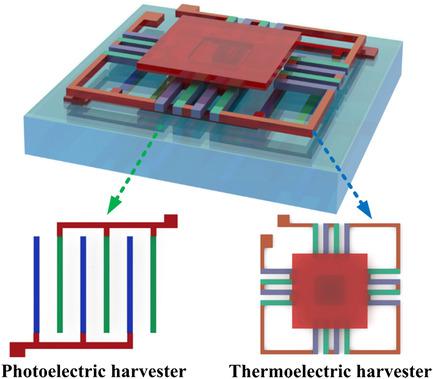当前位置:
X-MOL 学术
›
Energy Technol.
›
论文详情
Our official English website, www.x-mol.net, welcomes your
feedback! (Note: you will need to create a separate account there.)
Research on Micro-Electro-Mechanical System-Based Integrated Energy Harvester with Test Structures
Energy Technology ( IF 3.6 ) Pub Date : 2021-08-14 , DOI: 10.1002/ente.202100488 Sen Zhang 1 , Xiaoping Liao 1
Energy Technology ( IF 3.6 ) Pub Date : 2021-08-14 , DOI: 10.1002/ente.202100488 Sen Zhang 1 , Xiaoping Liao 1
Affiliation

|
Expansion of Internet of Things (IoT) in industrial fields requires a novel power supply. Research on a micro-electro-mechanical system (MEMS)-based integrated energy harvester with test structures for power supply is proposed. The MEMS fabrication process is applied and amended to achieve a better performance. A metal heat sink is fabricated at the center of the harvester for thermoelectric gathering. The photoelectric harvester is in the back of the device to integrate with the thermoelectric harvester. The output voltage factor and output power factor of the thermoelectric harvester are measured to be 0.58 V cm−2 K−1 and 2.76 × 10−2 μW cm−2 K−2. The efficiencies when the photoelectric harvester works with top and bottom sides, respectively, are 5.45% and 0.27%. In addition, several parameter test structures are designed to explain how external and internal parameters affect the performance of the proposed device. The maximum output power factor is found to be related to the length and width of the thermocouple. This relationship provides a way to amend the performance of the proposed device in our further research.
中文翻译:

基于微机电系统的带测试结构的集成能量采集器的研究
物联网 (IoT) 在工业领域的扩展需要新型电源。提出了一种基于微机电系统(MEMS)的带有电源测试结构的集成能量采集器的研究。应用和修改MEMS制造工艺以实现更好的性能。在收集器的中心制造了一个金属散热器,用于热电收集。光电采集器位于设备背面,与热电采集器集成在一起。热电采集器的输出电压因数和输出功率因数经测量为 0.58 V cm -2 K -1和 2.76 × 10 -2 μW cm -2 K -2. 光电采集器在顶面和底面工作时的效率分别为5.45%和0.27%。此外,还设计了几个参数测试结构来解释外部和内部参数如何影响所建议设备的性能。发现最大输出功率因数与热电偶的长度和宽度有关。这种关系提供了一种在我们的进一步研究中修改所提议设备性能的方法。
更新日期:2021-10-08
中文翻译:

基于微机电系统的带测试结构的集成能量采集器的研究
物联网 (IoT) 在工业领域的扩展需要新型电源。提出了一种基于微机电系统(MEMS)的带有电源测试结构的集成能量采集器的研究。应用和修改MEMS制造工艺以实现更好的性能。在收集器的中心制造了一个金属散热器,用于热电收集。光电采集器位于设备背面,与热电采集器集成在一起。热电采集器的输出电压因数和输出功率因数经测量为 0.58 V cm -2 K -1和 2.76 × 10 -2 μW cm -2 K -2. 光电采集器在顶面和底面工作时的效率分别为5.45%和0.27%。此外,还设计了几个参数测试结构来解释外部和内部参数如何影响所建议设备的性能。发现最大输出功率因数与热电偶的长度和宽度有关。这种关系提供了一种在我们的进一步研究中修改所提议设备性能的方法。











































 京公网安备 11010802027423号
京公网安备 11010802027423号